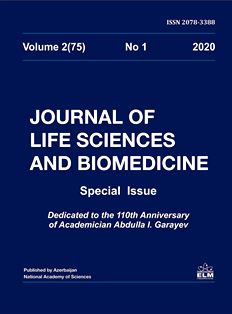
Comparative characteristics of bioelectric activity of the brain in long-livers from different regions of the Republic of Azerbaijan
Research article: Comparative characteristics of bioelectric activity of the brain in long-livers from different regions of the Republic of Azerbaijan
Authors: Y.O. Bayramova*, U.F. Hashimova
Academician Abdulla Garayev Institute of Physiology, Azerbaijan National Academy of Sciences, 78
Sharifzadeh Str., Baku AZ1100, Azerbaijan
*For correspondence: bayramova.physiolog@gmail.com
Accepted for publication: 17 April 2020
Abstract: With application of modern technique of computerized electroencephalography comparative data of spectral-frequency analysis of baseline electroencephalography of the long-livers having high in- dexes of longevity and living in southern part of Azerbaijan – in Lenkoran (most of the areas are plains) and Lerik (mountainous) regions – are presented in the article. The undertaken electrophy- siological studies revealed resembling and different features in the electroencephalogram (EEG) of the long-livers’ populations within the different geographic areas of Azerbaijan. On the basis of comparative analysis of the recordings of baseline EEG of the long-livers of both regions one can reveal protective and inhibitory effects of the sub-cortical structures on the activity of the cortex (coming from prevalence of the indexes of delta- and theta-rhythms) accompanied with their low activities. However, in the long-livers of the Lerik region, in contrast to the long-livers of the Len- koran region, compensatory upregulation of the activating effect of the mesencephalic reticular for- mation to the brain cortex was noticed. Along with the general properties of EEG, the differences in EEG patterns indicate different directions of the activation of the brain compensatory mechanisms, which gives grounds to put forward the conjecture saying that in relation to age-related changes, reorganization of neurons’ communications in the central nervous system and support of high level of the brain activity in the long-livers require engagement of much more internal resources.
Keywords: Long-livers, electroencephalogram, spectral analysis, spectral power, index, brain functional state.
References
Blalock E. M., Chen K. C., Sharrow K (2003) Gene microarrays in hippocampal aging: statisti-cal profiling identifies novel processes correla-ted with cognitive impairment. J. Neuroscience, 23: 3807-3819
Carlson C. E., St Louis E. D., Granner M. A. (2004) Yield of video EEG monitoring in pati-ents over the age of 50. Program and abstract of the American Epilepsy Society 58th Annual Meeting. Abstract 2: 226 p
Deryabina I.N. (2016) Characteristic of brain electrobiological activity in elderly women with different level of cognitive disorders. Human Ecology, 10: 51-56
Gomazkov O.A. (2012) Cellular and molecular principles of brain aging. J. Advances in Current Biology, 132(2): 141-154.
Gordeev S. A. (2007) Changes in electrical brain ac-tivity in patients with panic disorders. I.P.Pavlov Journal of Higher Nervous Activity, 57(3): 282-291.
Kambarova D.K., Belyayev V.V., Volkova A.V. et al. (2010) Methods of nonlinear dynamics in estimation of electroencephalograms of healthy people and of patients with epilepsy. J. of Evolu-tionary Biochemistry and Physiology, 46 (5): 501-510.
Kempermann G., Gast D., Gage F.H. (2002) Neuroplasticity in old age: Sustained fivefold in-duction of hippocampal neurogenesis by long-term environmental enrichment. Ann. Neurol., 52 (2): 135 p.
Klimesch W., Doppelmayr M., Hanslmayr S. (2006) Uppler alpha ERD and absolute power: their meaning for memory performance. Prog. Brain Res., 159: 151p.
Kozlov V.I. (1982) Study of the longevity prob-lems. In: Longevity phenomenom. Moscov: Nau-ka, p. 5-12
Kulaichev A.P. (2007) Computer electrophy-sio-logy and functional diagnostics. M.: Forum-Inf-ra, 640 p.
Kuznetsova S.M. (2008) On the question of the mechanisms of longevity: what is the secret of longevity? What determines the longevity phe-nomenon? Zdorove dovqolittya. Mediz Antia-ging. Healthy aging, 2 (02): 40-43
Liddell B.J., Paul R.H., Arns M. et al. (2007) Rates of decline distinguish Alzheimer,s disease and mild cognitive impairment relative to nor-mal aging: integrating cognition and brain func-tion. J. Integr. Neurosci., 6(1): 14 p
Marx E., Deutschlander A., Stephan T. et. al (2004) Eyes open and eyes closed as rest condi-tions, impact on brain activation patterns. Neu-roimage, 4: 1818 p.
McEvoy L.K., Pellouchoud E., Smith M.E., Ge-vins A. (2001)Neurophysiological signals of working memory in normal aging. Brain Res.: Cogn.Brain Res., 11: 363 p.
Moretti D. V., Frisoni G. B., Binetti G., Zanetti O. (2012) Mild cognitive impairment and quan-titative EEG markers: Degenerative versus vas-cular brain damage. Advances in Clinical Neu-rophysiology, p. 171-194.
Polunina A.G. (2012) Encephalogram charac-te-ristics in the assessment of cognitive functions. Nevrol. Psychiatric n.a. S.S. Korsakova, 112(7): 62-70.
Razoumnikova O.M. (2003) Reflection of the in-telligence structure in the spatiotemporal featu-res of the baseline EEG. Human Physiology. 29 (5): 115-122.Comparative characteristics of bioelectric activity of the brain in long-livers
Van Cott A.C. (2002) Epilepsy and EEG in the elderly. Epilepsia, 43(3): 94-102.
Volf N.V., Tarasova I.V. (2010) The relations-hips between EEG Θ and β oscillations and the level of creativity. Human Physiology, 36 (2): 132-138.
Volf N.V., Glukhih A.A. (2011) Background electrical activity of brain in healthy mental aging. Human Physiology, 37(5): 51-60.
Vysata O., Kukal J., Prochazka A., Pazdera L., Valis M. (2012) Age-related changes in the energy and spectral composition of EEG. Neu-ropsychology, 14(1): 63-67.
Zenkov L.R. (2010) Clinical epileptology. M.: Med. inform agency, p. 123-129.























